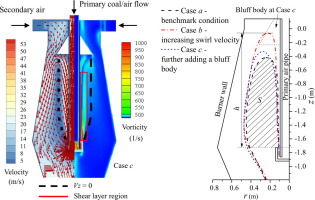Our official English website, www.x-mol.net, welcomes your feedback! (Note: you will need to create a separate account there.)
Recirculating structures and combustion characteristics in a reverse-jet swirl pulverized coal burner
Fuel ( IF 7.4 ) Pub Date : 2020-06-01 , DOI: 10.1016/j.fuel.2020.117456 Minhang Song , Qian Huang , Fang Niu , Shuiqing Li
Fuel ( IF 7.4 ) Pub Date : 2020-06-01 , DOI: 10.1016/j.fuel.2020.117456 Minhang Song , Qian Huang , Fang Niu , Shuiqing Li

|
Abstract Industrial pulverized coal boilers play an important role in the use of distributed energy, but still suffer from severe pollutant emissions, combustion instabilities and poor fuel adaptabilities. In this paper, numerical simulation and full-scale experiments were carried out to study the recirculating and combustion characteristics of a novel reverse-jet swirl pulverized coal burner with an adding bluff body and flexibly adjusted secondary air. The axial velocity stagnation contour and the out-of-plane vorticity contour were used to characterize the recirculation structure of reverse swirl flows. The original design achieves a moderate char burnout with the carbon content in fly ash to be 18.63% under a residence time of 0.158 s, which demands for the further improvements. However, if only the injection velocity of the secondary air is increased by halving the axial range of the swirl vane, the recirculating flow is strengthened to such an undesired degree that coal ignition appears in the primary air pipe, the burner-wall overheating and near-wall particle enrichment can occur. To overcome it, a bluff body was incorporated with the enhanced secondary air flow. The recirculation zone was restricted downstream the bluff body, thus eliminating possible early coal ignition. Besides, the width of the recirculating flow is broadened, resulting in a more stable combustion with a less fluctuated pressure signal at the furnace exit. The near-wall coal particle concentration is reduced by approximately 90%. As a result, the use of bluff body decreased the carbon content in fly ash to 8.55% by increasing the coal particle residence time to 0.171 s. In addition, the NO concentration at the burner outlet is decreased by 8% owing to a longer coal particle residence time in the reducing environment.
中文翻译:

逆喷旋流煤粉燃烧器的循环结构及燃烧特性
摘要 工业煤粉锅炉在分布式能源利用中发挥着重要作用,但仍存在污染物排放严重、燃烧不稳定、燃料适应性差等问题。本文通过数值模拟和全尺寸试验研究了一种新型加钝体和灵活调节二次风的逆喷旋流煤粉燃烧器的再循环和燃烧特性。轴向速度停滞等值线和平面外涡量等值线被用来表征反向涡流的再循环结构。原设计在0.158 s的停留时间下实现了中等烧焦,飞灰中碳含量为18.63%,需要进一步改进。然而,如果仅通过将旋流叶片轴向范围减半来增加二次风的喷射速度,则再循环流被加强到不希望的程度,以至于在一次风管中出现煤着火,燃烧器壁过热和近壁可以发生颗粒富集。为了克服它,一个钝体与增强的二次空气流相结合。再循环区被限制在钝体下游,从而消除了可能的早期煤点火。此外,再循环流的宽度变宽,导致燃烧更稳定,炉膛出口压力信号波动更小。近壁煤颗粒浓度降低约 90%。结果,使用钝体将飞灰中的碳含量降低到 8。通过将煤颗粒停留时间增加到 0.171 秒,增加了 55%。此外,由于煤颗粒在还原环境中的停留时间更长,燃烧器出口处的 NO 浓度降低了 8%。
更新日期:2020-06-01
中文翻译:

逆喷旋流煤粉燃烧器的循环结构及燃烧特性
摘要 工业煤粉锅炉在分布式能源利用中发挥着重要作用,但仍存在污染物排放严重、燃烧不稳定、燃料适应性差等问题。本文通过数值模拟和全尺寸试验研究了一种新型加钝体和灵活调节二次风的逆喷旋流煤粉燃烧器的再循环和燃烧特性。轴向速度停滞等值线和平面外涡量等值线被用来表征反向涡流的再循环结构。原设计在0.158 s的停留时间下实现了中等烧焦,飞灰中碳含量为18.63%,需要进一步改进。然而,如果仅通过将旋流叶片轴向范围减半来增加二次风的喷射速度,则再循环流被加强到不希望的程度,以至于在一次风管中出现煤着火,燃烧器壁过热和近壁可以发生颗粒富集。为了克服它,一个钝体与增强的二次空气流相结合。再循环区被限制在钝体下游,从而消除了可能的早期煤点火。此外,再循环流的宽度变宽,导致燃烧更稳定,炉膛出口压力信号波动更小。近壁煤颗粒浓度降低约 90%。结果,使用钝体将飞灰中的碳含量降低到 8。通过将煤颗粒停留时间增加到 0.171 秒,增加了 55%。此外,由于煤颗粒在还原环境中的停留时间更长,燃烧器出口处的 NO 浓度降低了 8%。



























 京公网安备 11010802027423号
京公网安备 11010802027423号